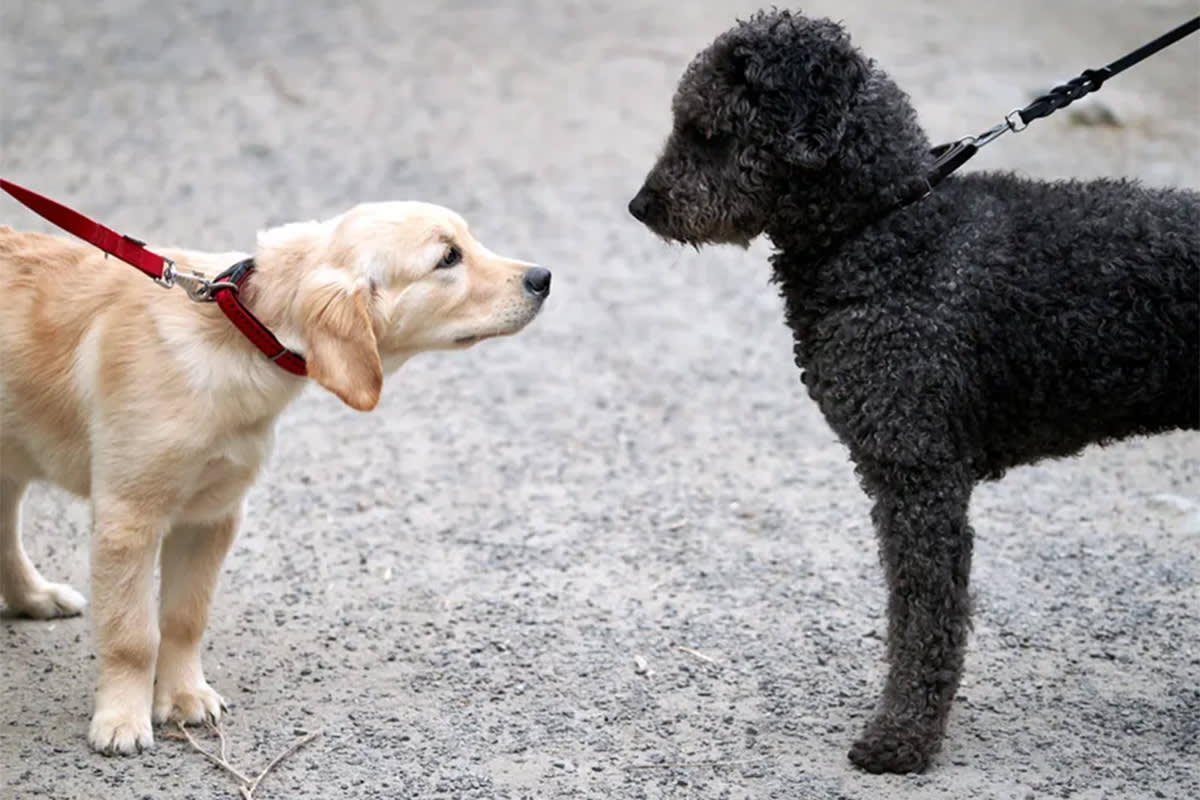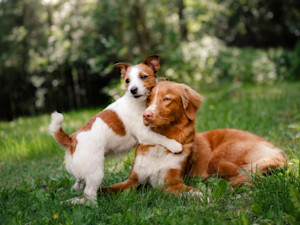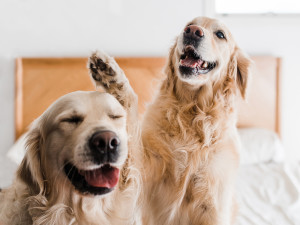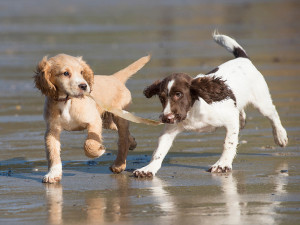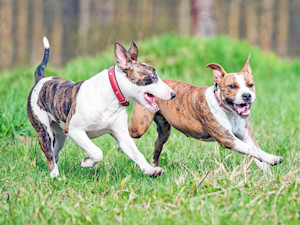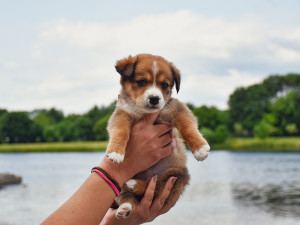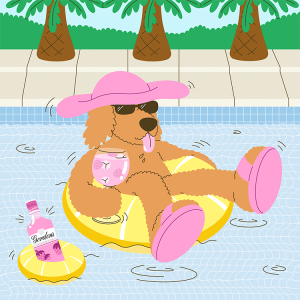3 Signs Your Dog Does Not Want a Canine Sibling
Some pups are just meant to be only children.
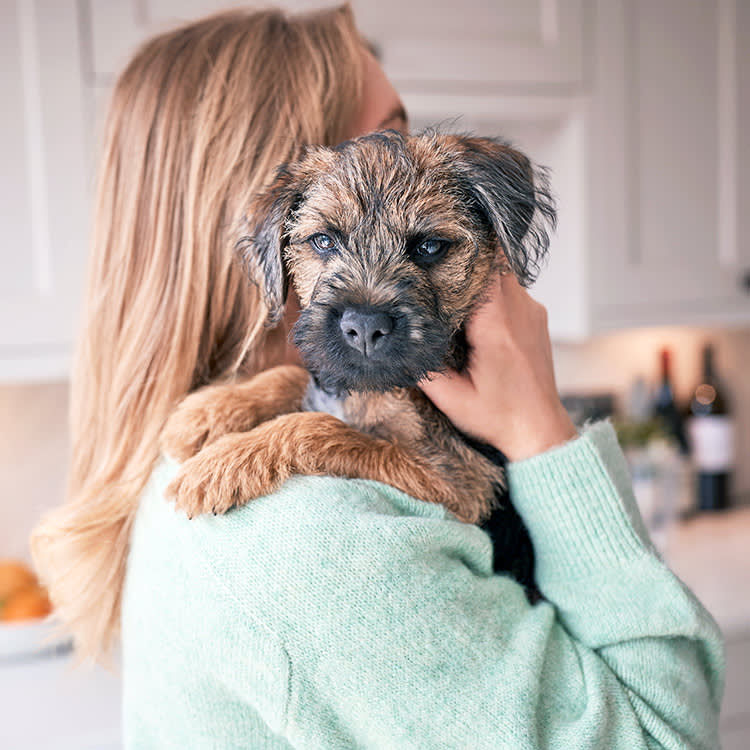
Share Article
A couple of years ago, I decided that my rescue dog, Claude, a quiet pup who was 10 years old at the time, might like some company. I decided to foster a four-pound Yorkie from a local rescue for her to hang out with.
Right away, they were slightly mismatched: Lulu, the foster, had a pixyish, spirited energy, while Claude — a 12-pound Schnauzer-Terrier mix — was much more reserved; Lulu sprinted ahead on walks while Claude stopped to smell the flowers. And Lulu had an adorable way of following me around that I was sure Claude, who preferred her independence, found annoying. Or was it my imagination?
Despite it all, I was certain that after a few nights, all would be well between the two of them — and that I might even adopt Lulu for good. Claude acquiesced the first day and tolerated Lulu… until bedtime. Claude always slept on my bed, so of course I let Lulu, too. But as soon as both dogs were there and we were ready to sleep, Claude peed all over the bedspread.
This was shocking behavior for her, as she’d never done it before.
How much do you spend on your pet per year?

Then the second night, Claude peed again.
And the third night. And the fourth night. And the fifth.
It was suddenly very clear to me: Claude wanted to be an only child, and I would not be adopting another pet. After going through this, I realize I can’t have been the only parent of a pet who preferred to remain solo. I spoke with experts to get some advice for anyone else who’s wondering if adding another dog to their family is a terrible idea... or one their current pet will willingly accept.
Does your dog want to be an only child?
“Some dogs are certainly happier as an only child,” says Dr. Mike Herman, a veterinarian and medical director at Belcaro Animal Hospitalopens in new tab in Denver.
But does that mean they have a preference?
“The short answer is that there is no scientific literature supporting that dogs prefer to be an only child,” says Qiai Chong, the chief animal behaviorist at Pet Coachopens in new tab in Singapore. “Their experiences don’t align with human concepts of sibling rivalry or jealousy.”
However, that doesn’t mean that some pups don’t prefer to fly solo.
“As many see dogs as naturally pack animals, there is a general perception that a dog will be happier in the company of another dog,” says Dr. Kathryn Dench, a veterinarian and chief scientific advisor at Paw Originsopens in new tab in Chicago. “But in my experience, this is often not the case.”
She notes that the stress of conflict with other dogs in the house can outweigh any positive benefits of having a social companion. “I’d estimate around two in five dogs show clear signs of stress or discomfort when a new dog joins the household, as the social hierarchy adjusts to accommodate the new individual,” Dr. Dench says.
I tried to show equal affection to both Lulu and Claude — and give Claude a little extra cuddle when Lulu took the limelight — but the extra attention didn’t help, either. As it turns out, Claude might have been upset about what she perceived as a sudden threat to what belonged to her.
“The challenge comes from how dogs negotiate resources,” Chong says. “Dogs that are predisposed to guarding toys, food, resting spots, or even your attention may find introductions tricky because they want to maintain access to what’s valuable to them.”
These dogs may even show signs of resource guarding, like growling or baring teeth when another dog gets near their food, toys, or bed. And don’t forget your dog’s biggest resource: you. “We are the biggest resource, so we should consider that when deciding on adding another pup,” Dr. Herman says.
It’s easy to say that your dog is “jealous” of your relationship with the new pup, but that would be an overstatement.
In fact, it’s more about “security and predictability,” Dr. Dench says. Your dog may think that their life is being interrupted in a way that will not be in their best interest. “A new dog disrupts this dynamic, creating competition for valued resources such as your attention, resting spots, and even scent cues in the home,” she adds.
What are the signs your dog doesn’t want a sibling?
Not every dog will appreciate a canine buddy, and that’s OK. But how do you know if your dog wants a friend? “Dogs don’t think in terms of ‘wanting’ or ‘not wanting’ a sibling, but some dogs have traits that can make living with another dog more challenging,” Chong says.
Here are some signs your dog isn’t the best fit for a sibling:
Your dog is fearful around other pups.
This might seem like a given, but it’s important to respect your dog’s comfort level. “Because you can’t always predict how the other dog will respond, fear can escalate into conflict, making introductions more complex,” Chong says.
Your dog and their new potential bestie have drastically different energy levels.
“A highly playful dog may try to engage a calmer dog who wants to rest,” Chong says. “If we don’t guide the higher-energy dog to settle or respect boundaries, frustration can build, sometimes leading to snapping or other undesirable behaviors.”
Your dog isn’t well-socialized.
Whether your dog will adapt to a new friend can also depend on personality and, early socialization — which can be challenging to ascertain, since socialization often happens early on in a dog’s life, usually before you adopt. “That critical piece of development often happens before we have our pups, especially with our rescues,” Dr. Herman says.
However, you can usually get a sense of whether your dog is a lone wolf or a social butterfly by observing them when you’re out and about. “When out on walks or spending time with friends who have dogs, pay attention to how your only-child dog is behaving with their peers,” Dr. Dench says.
Dr. Dench suggests asking yourself the following questions:
Does my dog socialize appropriately? For example, did they do a quick mutual sniff of the rear end? Are they displaying good body language that communicates play?
Does my dog give other dogs space when they’re done playing, or does the other dog have to snap to tell them to back off?
Does my dog sometimes let their friend go first if toys or food are involved?
Even if you do your homework and gauge whether your dog is or isn’t a candidate for a bestie, there’s still a chance they could say absolutely not once the new pup touches down at your place.
Here are some initial signs that your dog isn’t a fan of the new ball of fur next to them on the couch:
Unusual and sudden disobedience
Anxiety in a dog who usually isn’t anxious
Hypervigilance
Avoiding certain areas
Resource guarding
Don’t think of these issues as your pup “acting out,” Dr. Dench says, but instead more as “behaviors that result from overwhelm.”
What’s more, “these behaviors aren’t a conscious ‘veto’ of the new dog,” Chong says. “They are signals that your dog needs support and clear structure to navigate interactions with a new companion.”
How can you help your dog navigate a new pup in the house?
When you bring a new dog home, don’t expect them to just figure it out on their own. And don’t expect your current dog to immediately adapt. Because Claude and Lulu were both small, well-behaved dogs, I didn’t put much thought into how they would get along — I just assumed that they naturally would. And I could have done a better job of putting structure in place too.
“When introducing a second dog into the home, it's essential to recognize that you're not only welcoming a new pet but also introducing a new dynamic,” Chong says.
Once again, this goes back to resource guarding — Claude was likely confused about whether her resources would still be available to her. “Dogs often show preference over specific resources, such as toys, beds, or attention,” Chong says. “Without proper guidance, these preferences can lead to tension or conflict between dogs.”
Chong suggests games where a pet parent takes turns playing tug with one dog while the second dog waits patiently on a dog bed. When the first dog’s turn is over, they swap spots. “This structured turn-taking helps both dogs enjoy interaction with the handler and access resources peacefully,” Chong says.
Slow introductions, separate feeding and sleep areas, and parallel walksopens in new tab can also boost positive associations and confidence, Dr. Dench says. “But some dogs may never fully relax around others — and that’s OK,” she adds. “Respecting a dog’s individuality is one of the kindest things an owner can do.”
At the end of the day, I decided to do just that: respect Claude’s individuality. A behavior like peeing on the bed wasn’t a “deliberate message,” Chong says, but more so likely “a response to stress, anxiety, or changes” in Claude’s environment. “Your dog’s peeing likely reflected tension from the new household dynamic, such as managing another dog’s presence, negotiating resources, or adjusting to new routines.”
Dr. Dench adds one more thing that resonates with me: “Some breeds or personalities — particularly older dogs, rescues with trauma, or low-confidence individuals — may struggle more with these changes.”
That made so much sense for Claude: She was a senior, she was a rescue with a traumatic background, and she had not always had the confidence she’d worked so hard to build after she was rescued. I had clearly expected her to slip easily into the role of “big sister,” which wasn’t quite fair of me.
In the end, Lulu got adopted by an amazing person in Brooklyn who takes her everywhere (Claude’s worst nightmare), spends hours playing fetch (Claude was not into games), and sets Lulu up on playdates with another Yorkie she adores (Claude was never a fan of playdates). So, by maintaining a one-pup home, Claude and I got to spend the best of her senior years together, walking as slowly and purposefully as she liked, stopping to smell every single flower.
Maybe part of me already knew that Claude was happy with just the two of us. She passed away this past May, and now I have a new pup, a 12-year-old senior girl named Gus. Gus is an anxious dog who avoids other pups on the street and prefers to be in charge at home. So, knowing all this, I won’t be getting her a sibling (I learned my lesson): Listen to your dog, and don’t force something on them that they definitely don’t want.
“Most of us know our four-legged friends well, and we should trust what our instincts tell us,” Dr. Herman says. “Ask yourself if you think your pup would do well with a sibling, because we often already know the answer deep down.”

Marti Trgovich
Marti Trgovich is a writer specializing in pets and wildlife. She has written about animals for National Geographic, The Washington Post, Newsweek, and other publications, and she spent nearly a decade as an editor at The Dodo. Her favorite animals are guinea pigs, sheep, and small, saucy senior dogs.
Related articles
![Two dogs hugging]()
5 Signs Your Dog Needs More Dog Friends
Maybe your pup needs a playdate.
![Two happy Golden Retriever dogs sitting on the bed together]()
Do Dogs Have Besties?
They’re not exactly crafting friendship bracelets for each other, but dog bonds mean something.
![two small puppies play on a beach]()
Here’s Why You Need to Socialize Your Dog ASAP
Waiting until full vaccination to socialize can cause huge problems for your pup.
![Two dogs playing together outside.]()
4 Signs Your Dog Would Like a Sibling
You want a second dog, but is your pup into the idea?
![Big dog sniffs little dog in greeting]()
How to Properly Introduce Two Pups
There’s a lot more to it than sniffing each other’s butts.
![Two hands holding a very young tan and white puppy up in front of a lake landscape]()
How to Socialize a Puppy
Everything you need to know to get your new addition off to a good start.
![illustration of a dog in a pool with a pink hat and pink shoes]()
Anthropomorphizing Your Pets Can Actually Benefit Them—and You
If your friends make fun of you for treating your dog like a human being, send them this.

